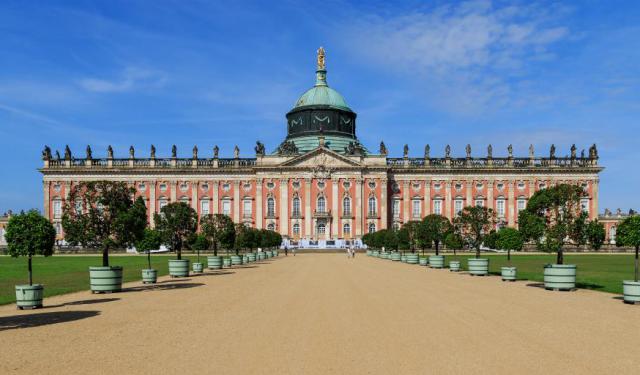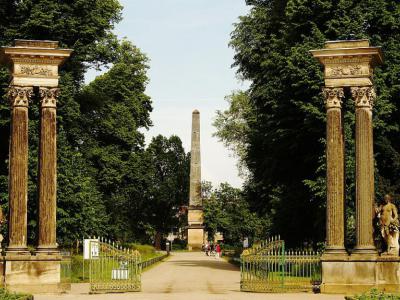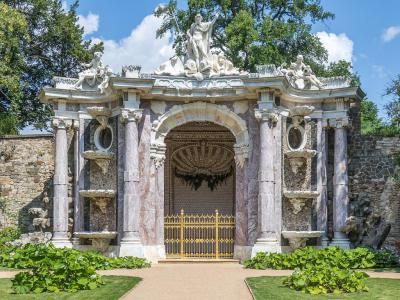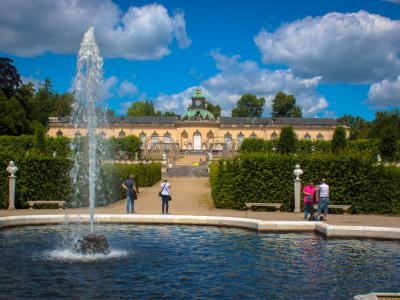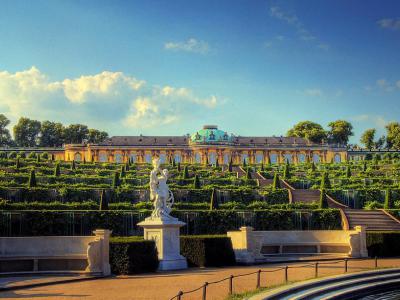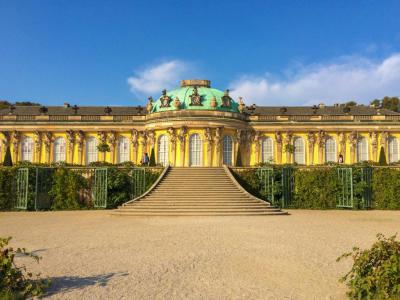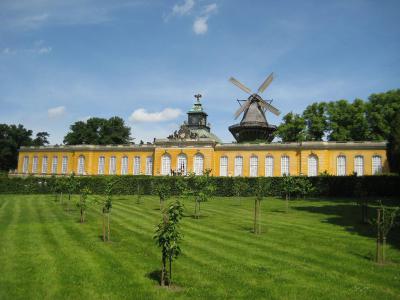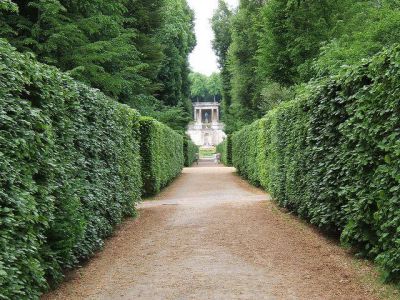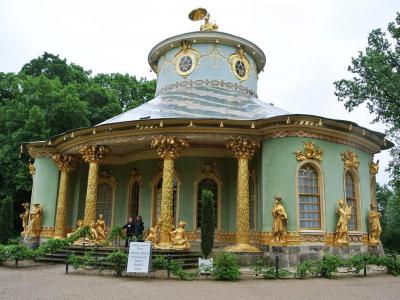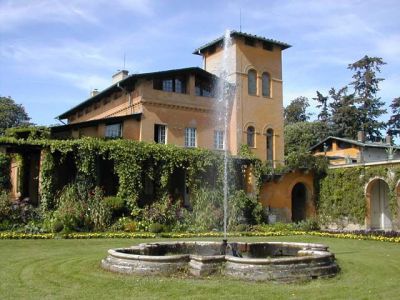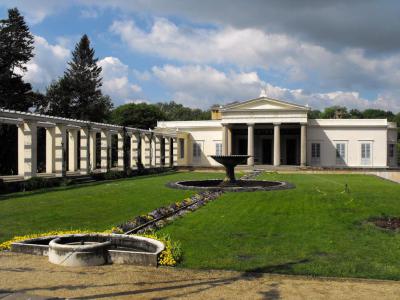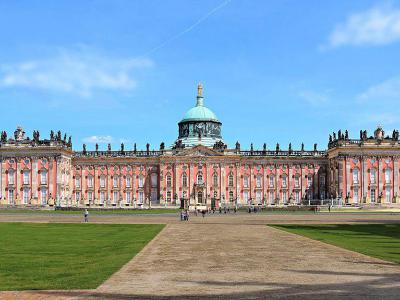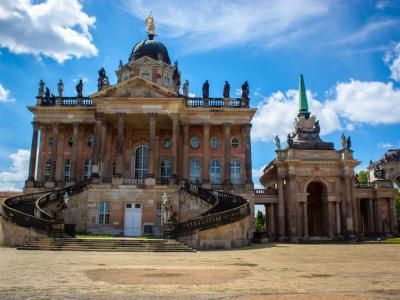Sanssouci Park Walking Tour (Self Guided), Potsdam
Sanssouci Park is a unique Potsdam landmark that occupies 290 hectares in the heart of the city. The Park is named after the Sanssouci Palace that it surrounds, which in turn takes its name from the French phrase "sans souci", which means carefree, and implies that the palace was designated as a place of fun, rather than a seat of power.
Indeed, the Sanssouci Palace was built in 1747 as a summer residence for Prussia's king Frederick the Great (1712-1786). The latter was an enlightened monarch, passionate about the arts, who counted among his closest friends the likes of French philosopher Voltaire and many prominent celebrities of the time. In his organization of the park, Frederick deviated from the classical layout of Baroque gardens, seeking to combine the beautiful and the useful.
Sanssouci Park is a home to a number of historic buildings, such as the Charlottenhof Palace, the Roman Baths and the Temple of Friendship, surrounded by broad meadows creating visual avenues. Marking the eastern entrance to the Park is an Obelisk, established in 1748. Beginning from here a 2.5-km main avenue extends all the way to the New Palace, which marks its end in the west. In 1764 the Picture Gallery was constructed, followed by the New Chambers added in 1774. Frederick invested heavily in the fountain system of Sanssouci Park, which, among other features, included the Neptune Grotto, completed in 1757. The Sanssouci Park grounds are free to enter, and you can stroll around and view these and other attractions from outside at no charge. If you're keen to learn about the history of Prussia during the reign of Frederick the Great whilst enjoying yourself, take our self-guided walk through this marvelous park!
Indeed, the Sanssouci Palace was built in 1747 as a summer residence for Prussia's king Frederick the Great (1712-1786). The latter was an enlightened monarch, passionate about the arts, who counted among his closest friends the likes of French philosopher Voltaire and many prominent celebrities of the time. In his organization of the park, Frederick deviated from the classical layout of Baroque gardens, seeking to combine the beautiful and the useful.
Sanssouci Park is a home to a number of historic buildings, such as the Charlottenhof Palace, the Roman Baths and the Temple of Friendship, surrounded by broad meadows creating visual avenues. Marking the eastern entrance to the Park is an Obelisk, established in 1748. Beginning from here a 2.5-km main avenue extends all the way to the New Palace, which marks its end in the west. In 1764 the Picture Gallery was constructed, followed by the New Chambers added in 1774. Frederick invested heavily in the fountain system of Sanssouci Park, which, among other features, included the Neptune Grotto, completed in 1757. The Sanssouci Park grounds are free to enter, and you can stroll around and view these and other attractions from outside at no charge. If you're keen to learn about the history of Prussia during the reign of Frederick the Great whilst enjoying yourself, take our self-guided walk through this marvelous park!
How it works: Download the app "GPSmyCity: Walks in 1K+ Cities" from Apple App Store or Google Play Store to your mobile phone or tablet. The app turns your mobile device into a personal tour guide and its built-in GPS navigation functions guide you from one tour stop to next. The app works offline, so no data plan is needed when traveling abroad.
Sanssouci Park Walking Tour Map
Guide Name: Sanssouci Park Walking Tour
Guide Location: Germany » Potsdam (See other walking tours in Potsdam)
Guide Type: Self-guided Walking Tour (Sightseeing)
# of Attractions: 13
Tour Duration: 2 Hour(s)
Travel Distance: 3.9 Km or 2.4 Miles
Author: DanaOffice
Sight(s) Featured in This Guide:
Guide Location: Germany » Potsdam (See other walking tours in Potsdam)
Guide Type: Self-guided Walking Tour (Sightseeing)
# of Attractions: 13
Tour Duration: 2 Hour(s)
Travel Distance: 3.9 Km or 2.4 Miles
Author: DanaOffice
Sight(s) Featured in This Guide:
- Obelisk
- Neptune Grotto
- Bildergalerie (Picture Gallery)
- Terraced Gardens
- Sanssouci Palace
- New Chambers
- The Labyrinth
- Chinese House
- Roman Baths
- Charlottenhof Palace
- Temple of Friendship
- New Palace
- Communs
1) Obelisk
Potsdam is a city that has a significant number of memorials, monuments and public art displays. Several obelisks can be found throughout Potsdam. However, when one speaks of The Obelisk, they are referring to the Obeliskportal in Sanssouci Park.
The Obelisk is located at the eastern entrance to Sanssouci Park. It was was erected at the behest of Frederick the Great in 1747 from a design by Georg Wenzeslaus von Knobelsdorff. The Obelisk, along with accompanying sandstone statues, was meant as a decorative piece for visitors to see as they exited the park.
The Obelisk is distinctive for having ornate hieroglyphs carved throughout. These hieroglyphs are purely created using artistic vision. They cannot be translated into actual words, sentences or stories.
Sanssouci Park is the park surrounding Sanssouci Palace. The park is open daily from 6 AM through dusk. There is no charge for entering the park but donations are accepted.
The Obelisk is located at the eastern entrance to Sanssouci Park. It was was erected at the behest of Frederick the Great in 1747 from a design by Georg Wenzeslaus von Knobelsdorff. The Obelisk, along with accompanying sandstone statues, was meant as a decorative piece for visitors to see as they exited the park.
The Obelisk is distinctive for having ornate hieroglyphs carved throughout. These hieroglyphs are purely created using artistic vision. They cannot be translated into actual words, sentences or stories.
Sanssouci Park is the park surrounding Sanssouci Palace. The park is open daily from 6 AM through dusk. There is no charge for entering the park but donations are accepted.
2) Neptune Grotto
The Neptune Grotto (Neptungrotte) is a historic Rococo structure located in Sanssouci Park, Potsdam. It was commissioned by Frederick the Great, the ruler of Prussia, between 1751 and 1757 as part of his efforts to enhance the park's beauty. Designed by architect Georg Wenzeslaus von Knobelsdorff, the grotto is a testament to the 18th-century fascination with combining architecture and nature.
The grotto's design revolves around Neptune, the Roman god of the sea, symbolizing water, although the original fountains were non-functional due to the technological limitations of the time. It was not until nearly a century later, with the construction of a pump house and the advent of steam power, that the fountains around the grotto became operational.
The structure is characterized by intricate carvings and decorations that reflect Neptune's aquatic domain. A statue of Neptune wielding a trident stands above the entrance, and conches on the sides are designed to resemble cascading waterfalls. Inside the grotto, the decor includes shells, reed flowers, and crystals, with a large shell centerpiece crafted from real shells.
Positioned near the Obelisk entrance of the park, the grotto was recently renovated in 2018, preserving its historical significance and artistic appeal. Visitors can explore this unique monument during Sanssouci Park's opening hours, which run from 6 AM to dusk throughout the year.
The grotto's design revolves around Neptune, the Roman god of the sea, symbolizing water, although the original fountains were non-functional due to the technological limitations of the time. It was not until nearly a century later, with the construction of a pump house and the advent of steam power, that the fountains around the grotto became operational.
The structure is characterized by intricate carvings and decorations that reflect Neptune's aquatic domain. A statue of Neptune wielding a trident stands above the entrance, and conches on the sides are designed to resemble cascading waterfalls. Inside the grotto, the decor includes shells, reed flowers, and crystals, with a large shell centerpiece crafted from real shells.
Positioned near the Obelisk entrance of the park, the grotto was recently renovated in 2018, preserving its historical significance and artistic appeal. Visitors can explore this unique monument during Sanssouci Park's opening hours, which run from 6 AM to dusk throughout the year.
3) Bildergalerie (Picture Gallery)
The Sanssouci Park Picture Gallery, known in German as the Bildergalerie, is a museum that displays the art collection of Frederick the Great. Construction was completed in 1764 under the directive of the Prussian ruler. It is known to be the oldest extant museum built for a ruler in the country.
Bildergalerie was designed by Johann Gottfried Buring on the grounds of a former greenhouse. The interior is decorated with gold ornaments, Italian marble and a domed ceiling. Outside, the garden-facing side of the building features statues by Johann Gottlieb Heymuller and Johann Peter Benckert. The statues represent figures from arts and sciences.
Frederick the Great collected paintings throughout his life. French Rococo art, especially those by Antoine Watteau, were early favorites of the ruler. He later collected more Renaissance and Baroque art including works by Rubens, Rembrandt and Correggio.
All of the paintings were moved to Rheinsberg Palace during World War II. Many of the paintings were lost. However, a large collection of paintings confiscated by the Soviet Union was returned in 1958. Some of the portraits in Bildergalerie include the Incredulity of Saint Thomas by Caravaggio and Saint Hieronymus and Four Evangelists by Peter Paul Rubens.
Bildergalerie was designed by Johann Gottfried Buring on the grounds of a former greenhouse. The interior is decorated with gold ornaments, Italian marble and a domed ceiling. Outside, the garden-facing side of the building features statues by Johann Gottlieb Heymuller and Johann Peter Benckert. The statues represent figures from arts and sciences.
Frederick the Great collected paintings throughout his life. French Rococo art, especially those by Antoine Watteau, were early favorites of the ruler. He later collected more Renaissance and Baroque art including works by Rubens, Rembrandt and Correggio.
All of the paintings were moved to Rheinsberg Palace during World War II. Many of the paintings were lost. However, a large collection of paintings confiscated by the Soviet Union was returned in 1958. Some of the portraits in Bildergalerie include the Incredulity of Saint Thomas by Caravaggio and Saint Hieronymus and Four Evangelists by Peter Paul Rubens.
4) Terraced Gardens (must see)
The Terraced Gardens are an impressive part of the Sanssouci Palace. This location was previously a wooded vista. However, Frederick William I wanted to transform the area. In 1744, the hillside was changed into six terraces.
The terraces feature convex centers that maximize sunlight. One hundred sixty-eight glazed niches are featured among the wall’s brickwork.
Trellised vines were planted in front of the bricks, and figs were planted in the niches. The terraces also have strips of lawn with yew trees. The gardens feature a circular ornamental parterre created with trellised fruit hedging. One hundred and thirty-two steps lead downward and divide the terraces.
Below the terraces, visitors will find a beautiful ornamental garden. The “Great Fountain” was built in 1748. Then, in 1750, marble statues were added around the fountain. This idea was copied from Versailles and the French King Louis XV gifted several statues, including Venus and Mercury. The other statues represent Apollo, Diana, Jupiter, Mars, Juno, and Minerva.
The terraces feature convex centers that maximize sunlight. One hundred sixty-eight glazed niches are featured among the wall’s brickwork.
Trellised vines were planted in front of the bricks, and figs were planted in the niches. The terraces also have strips of lawn with yew trees. The gardens feature a circular ornamental parterre created with trellised fruit hedging. One hundred and thirty-two steps lead downward and divide the terraces.
Below the terraces, visitors will find a beautiful ornamental garden. The “Great Fountain” was built in 1748. Then, in 1750, marble statues were added around the fountain. This idea was copied from Versailles and the French King Louis XV gifted several statues, including Venus and Mercury. The other statues represent Apollo, Diana, Jupiter, Mars, Juno, and Minerva.
5) Sanssouci Palace (must see)
Sanssouci Palace was built by Frederick the Great between 1745 and 1747 and served as his summer palace. The palace’s name means “without concern,” alluding to its function as a restful retreat.
Frederick the Great wanted to cultivate grapes, figs, and plums and designed a terrace and gardens. The restful palace was Frederick the Great’s favorite residence. The palace has a grand facade but originally had just ten main rooms located on a single level.
Sanssouci Palace features Rococo style with ornate reliefs and elaborate tapestries. The style is so unique that it is known as Frederician Rococo.
The interior features beautiful architecture. The Concert Room hosted the king’s flute concerts. The Fourth Guest Room is thought to be the room that renowned philosopher Voltaire stayed in when visiting Sanssouci. The Library has cedar paneling and houses about 2000 books. During Frederick’s reign, the books were all in French, as French was thought to be more elite than German.
Frederick the Great’s tomb is located on the palace’s highest terrace. He was buried next to his beloved dogs in his favorite place on earth.
Frederick William IV enlarged the palace during the 19th century. The palace now operates as a museum and is part of the UNESCO World Heritage Site. The palace is located in Sanssouci Park, which features several buildings, including the New Palace, Chinese House, Dragon House, Roman Baths, and the Church of Peace.
In the summer, the palace hosts Potsdam Palace Nights. The gardens are lit up, and guests are treated to classical music. Actors dress in period costumes and mingle with guests. The palace also hosts dance and theater performances as well as lectures. On the weekends, the night ends with midnight fireworks.
Frederick the Great wanted to cultivate grapes, figs, and plums and designed a terrace and gardens. The restful palace was Frederick the Great’s favorite residence. The palace has a grand facade but originally had just ten main rooms located on a single level.
Sanssouci Palace features Rococo style with ornate reliefs and elaborate tapestries. The style is so unique that it is known as Frederician Rococo.
The interior features beautiful architecture. The Concert Room hosted the king’s flute concerts. The Fourth Guest Room is thought to be the room that renowned philosopher Voltaire stayed in when visiting Sanssouci. The Library has cedar paneling and houses about 2000 books. During Frederick’s reign, the books were all in French, as French was thought to be more elite than German.
Frederick the Great’s tomb is located on the palace’s highest terrace. He was buried next to his beloved dogs in his favorite place on earth.
Frederick William IV enlarged the palace during the 19th century. The palace now operates as a museum and is part of the UNESCO World Heritage Site. The palace is located in Sanssouci Park, which features several buildings, including the New Palace, Chinese House, Dragon House, Roman Baths, and the Church of Peace.
In the summer, the palace hosts Potsdam Palace Nights. The gardens are lit up, and guests are treated to classical music. Actors dress in period costumes and mingle with guests. The palace also hosts dance and theater performances as well as lectures. On the weekends, the night ends with midnight fireworks.
6) New Chambers
The New Chambers, or Neue Kammern in German, is a building in Sanssouci Park. It sits west of Sanssouci Palace to balance the Bildergalerie on the east. It was built as a guesthouse on the order of Frederick the Great in 1775.
Just as the Bildergalerie was constructed on the site of a greenhouse, the New Chambers building was constructed on what was once an orangery. The original building was designed in 1747 by George Wenzeslaus von Knobelsdorff. The reconstruction was managed by Georg Christian Unger in the Frederican Rococo architectural style.
Though the building was reconstructed, much of the original construction were left in place. This included the french doors and the ramps that were used to move potted plants in and out of the orangery. The cupola was added during the rebuild. Seven guests rooms and two ballrooms were created from a design by Johann Christian Hoppenhaupt. The largest of the ballrooms, the Jasper Room, lies directly under the cupola.
Along with Sanssouci Palace and its garden, the New Chambers was named a UNESCO World Heritage Site in 1990.
Just as the Bildergalerie was constructed on the site of a greenhouse, the New Chambers building was constructed on what was once an orangery. The original building was designed in 1747 by George Wenzeslaus von Knobelsdorff. The reconstruction was managed by Georg Christian Unger in the Frederican Rococo architectural style.
Though the building was reconstructed, much of the original construction were left in place. This included the french doors and the ramps that were used to move potted plants in and out of the orangery. The cupola was added during the rebuild. Seven guests rooms and two ballrooms were created from a design by Johann Christian Hoppenhaupt. The largest of the ballrooms, the Jasper Room, lies directly under the cupola.
Along with Sanssouci Palace and its garden, the New Chambers was named a UNESCO World Heritage Site in 1990.
7) The Labyrinth
The Labyrinth in Potsdam is a captivating feature of Sanssouci Park, located directly in front of the New Chambers. This beloved attraction is an integral part of the expansive 700-acre park, which is renowned for its rich history and stunning garden design. The maze itself is crafted from meticulously maintained shrubs that stand over six feet high, creating a simple yet thrilling adventure for visitors. As one navigates through the shrubbery walls, one will encounter a variety of trees, smaller shrubs, cobbled walkways, and statues, enhancing the maze's charm and intrigue.
For those who prefer not to enter the maze, the sloping landscape offers an alternative viewing point from the steps of the New Chambers, allowing them to appreciate the labyrinth's layout from a distance. The area encompassing the Labyrinth is sometimes referred to as "Carre Voltaire," a nod to Frederick the Great's close friend, the French philosopher Voltaire. This designation also extends to a wildlife refuge within the park.
Sanssouci Park, a UNESCO World Heritage Site since 1990, is celebrated for its distinctive terraced grounds and the majestic central fountain. Designed by Frederick the Great in 1743, the park initially featured terraces dedicated to viticulture and the king’s grave site. The park was later expanded by King Frederick William IV, blending Frederick’s intimate French pleasure garden with a picturesque 19th-century landscaped park adorned with Neoclassical and German Romantic architectural elements.
Visitors to Sanssouci Park can explore a diverse range of garden styles, reflecting the aesthetics and philosophies of past inhabitants. The park is home to exquisitely designed individual gardens, fountains, and over 1,000 sculptures, offering a glimpse into the artistic and architectural mastery of the most accomplished architects and sculptors of their times.
For those who prefer not to enter the maze, the sloping landscape offers an alternative viewing point from the steps of the New Chambers, allowing them to appreciate the labyrinth's layout from a distance. The area encompassing the Labyrinth is sometimes referred to as "Carre Voltaire," a nod to Frederick the Great's close friend, the French philosopher Voltaire. This designation also extends to a wildlife refuge within the park.
Sanssouci Park, a UNESCO World Heritage Site since 1990, is celebrated for its distinctive terraced grounds and the majestic central fountain. Designed by Frederick the Great in 1743, the park initially featured terraces dedicated to viticulture and the king’s grave site. The park was later expanded by King Frederick William IV, blending Frederick’s intimate French pleasure garden with a picturesque 19th-century landscaped park adorned with Neoclassical and German Romantic architectural elements.
Visitors to Sanssouci Park can explore a diverse range of garden styles, reflecting the aesthetics and philosophies of past inhabitants. The park is home to exquisitely designed individual gardens, fountains, and over 1,000 sculptures, offering a glimpse into the artistic and architectural mastery of the most accomplished architects and sculptors of their times.
8) Chinese House
The Chinese House, also known in Germany as the Chinese Teahouse, is a garden pavilion in Sanssouci Park. Like much of the park, the Chinese House was built in 1764 at the behest of Frederick the Great. The building functioned as the setting for small social events but was primarily a decorative outbuilding that added a point of interest to the garden.
The Chinese House was designed by architect Johann Gottfriend Buring in Chinoiserie style. This trendy architectural technique combined ornamental Rococo with Chinese influences. The house was modeled from a similar Chinese house on the grounds of the Maison du Trefle in Luneville, France designed by Emmanuel Here de Corny.
The house has a trefoil shape with a rounded central building, rounded windows and gilded columns. Golden sculptures at the feet of the columns were crafted by sculptors Johann Gottlieb Heymuller and Johann Peter Benckert. The cupola atop the roof features a Chinese statue created by Friedrich Jury.
The Chinese House was designed by architect Johann Gottfriend Buring in Chinoiserie style. This trendy architectural technique combined ornamental Rococo with Chinese influences. The house was modeled from a similar Chinese house on the grounds of the Maison du Trefle in Luneville, France designed by Emmanuel Here de Corny.
The house has a trefoil shape with a rounded central building, rounded windows and gilded columns. Golden sculptures at the feet of the columns were crafted by sculptors Johann Gottlieb Heymuller and Johann Peter Benckert. The cupola atop the roof features a Chinese statue created by Friedrich Jury.
9) Roman Baths
The Roman Baths in Potsdam form a picturesque ensemble that contrasts with the austere Charlottenhof Palace nearby. This Romantic complex evokes the atmosphere of an Italian estate, complete with herms of Dionysus, fragments of Pompeian columns, an ancient Centaur sarcophagus, and gardens filled with southern vegetables and lush decorative plants, creating an idealized vision of Italy.
The concept of the Roman Baths was heavily influenced by Crown Prince Frederick William IV, who later became King. He was a talented draftsman and provided numerous sketches that laid out his vision for this unique architectural ensemble. His ideas were brought to life by renowned architects Karl Friedrich Schinkel and Ludwig Persius. Starting in 1829, a series of structures were built, including the Court Gardener’s House, a pavilion resembling a Roman podium temple with a pillared portico, the Gardener’s Assistant’s House, the Large Arbor, the Arcade Hall, and finally, the Roman Baths.
Contrary to what their name might suggest, the Roman Baths were not designed as a replica of Roman thermal baths or an ancient villa. Instead, Frederick William IV envisioned a new architectural creation inspired by a 15th-century Italian country house. The design playfully incorporated elements of ancient building techniques, informed by recent archaeological discoveries in Herculaneum and Pompeii. The informal sequence of rooms and spaces, including the Atrium, Impluvium, Caldarium, Apodyterium, Viridarium, and Billiard Room, reflect this blend of historical styles.
The Roman Baths feature distinctive architectural elements, such as flat and saddleback roofs, a tower, asymmetrically connected components, and pergolas adorned with vine leaves. A terrace provides a scenic view across a pond toward Charlottenhof Palace, further enhancing the site's unique character. The surrounding landscaped park, designed by the famed garden designer Peter Joseph Lenné, complements the architectural ensemble. Notably, the Roman Baths served as a retreat for Frederick William IV and were also a residence for the distinguished scientist Alexander von Humboldt during his visits to Potsdam.
The concept of the Roman Baths was heavily influenced by Crown Prince Frederick William IV, who later became King. He was a talented draftsman and provided numerous sketches that laid out his vision for this unique architectural ensemble. His ideas were brought to life by renowned architects Karl Friedrich Schinkel and Ludwig Persius. Starting in 1829, a series of structures were built, including the Court Gardener’s House, a pavilion resembling a Roman podium temple with a pillared portico, the Gardener’s Assistant’s House, the Large Arbor, the Arcade Hall, and finally, the Roman Baths.
Contrary to what their name might suggest, the Roman Baths were not designed as a replica of Roman thermal baths or an ancient villa. Instead, Frederick William IV envisioned a new architectural creation inspired by a 15th-century Italian country house. The design playfully incorporated elements of ancient building techniques, informed by recent archaeological discoveries in Herculaneum and Pompeii. The informal sequence of rooms and spaces, including the Atrium, Impluvium, Caldarium, Apodyterium, Viridarium, and Billiard Room, reflect this blend of historical styles.
The Roman Baths feature distinctive architectural elements, such as flat and saddleback roofs, a tower, asymmetrically connected components, and pergolas adorned with vine leaves. A terrace provides a scenic view across a pond toward Charlottenhof Palace, further enhancing the site's unique character. The surrounding landscaped park, designed by the famed garden designer Peter Joseph Lenné, complements the architectural ensemble. Notably, the Roman Baths served as a retreat for Frederick William IV and were also a residence for the distinguished scientist Alexander von Humboldt during his visits to Potsdam.
10) Charlottenhof Palace
Charlottenhof Palace, situated southwest of Sanssouci Palace within the expansive Sanssouci Park in Potsdam, is a notable historical site recognized for its significance as the summer residence of Crown Prince Frederick William, who later became King Frederick William IV of Prussia. The area, with its roots in the 18th century, was transformed into its current form under the direction of the Crown Prince after receiving the land as a Christmas gift from his father, King Frederick William III, in 1825.
Originally the site of a modest farmhouse, the Crown Prince engaged the renowned architect Karl Friedrich Schinkel to remodel the structure into a Neoclassical palace. Schinkel, with assistance from his student Ludwig Persius, drew inspiration from Roman villas to create a small yet elegant palace, completed between 1826 and 1829. The interior, noted for its refined simplicity, was largely furnished with pieces designed by Schinkel himself.
The surrounding gardens, designed by the landscape architect Peter Joseph Lenné, were transformed from a flat, marshy area into a picturesque English garden. This landscaping effort seamlessly integrated Charlottenhof into the larger Sanssouci complex, enhancing its aesthetic appeal with trees, lawns, and water features.
One of the palace's most distinctive features is the "tent room," a guest bedroom designed to resemble a Roman Caesar's tent. This room, along with much of the palace, prominently features a blue-and-white color scheme, a tribute to the Bavarian heritage of Princess Elisabeth Ludovika, Frederick William's wife. The tent room's ceiling, walls, and window treatments all showcase this striped pattern, which extends throughout the palace, even to the shutters.
Charlottenhof Palace, named in honor of Maria Charlotte von Gentzkow, a previous owner of the property, has preserved much of its original interior design across its ten rooms. Since 1990, the palace has been recognized as part of the UNESCO World Heritage Site "Palaces and Parks of Potsdam and Berlin," underscoring its historical and cultural significance.
Originally the site of a modest farmhouse, the Crown Prince engaged the renowned architect Karl Friedrich Schinkel to remodel the structure into a Neoclassical palace. Schinkel, with assistance from his student Ludwig Persius, drew inspiration from Roman villas to create a small yet elegant palace, completed between 1826 and 1829. The interior, noted for its refined simplicity, was largely furnished with pieces designed by Schinkel himself.
The surrounding gardens, designed by the landscape architect Peter Joseph Lenné, were transformed from a flat, marshy area into a picturesque English garden. This landscaping effort seamlessly integrated Charlottenhof into the larger Sanssouci complex, enhancing its aesthetic appeal with trees, lawns, and water features.
One of the palace's most distinctive features is the "tent room," a guest bedroom designed to resemble a Roman Caesar's tent. This room, along with much of the palace, prominently features a blue-and-white color scheme, a tribute to the Bavarian heritage of Princess Elisabeth Ludovika, Frederick William's wife. The tent room's ceiling, walls, and window treatments all showcase this striped pattern, which extends throughout the palace, even to the shutters.
Charlottenhof Palace, named in honor of Maria Charlotte von Gentzkow, a previous owner of the property, has preserved much of its original interior design across its ten rooms. Since 1990, the palace has been recognized as part of the UNESCO World Heritage Site "Palaces and Parks of Potsdam and Berlin," underscoring its historical and cultural significance.
11) Temple of Friendship
The Temple of Friendship (Freundschaftstempel) is a small, round classical building located in Sanssouci Park, Potsdam. Commissioned by King Frederick II of Prussia in memory of his sister, Princess Wilhelmine of Prussia, who passed away in 1758, the temple was designed by architect Carl von Gontard and completed between 1768 and 1770. It stands south of the park's main boulevard, complementing the Temple of Antiquities, which lies directly north of the boulevard on the same axis.
The architectural design of the Temple of Friendship was inspired by the ancient Greek monopteros, characterized by its open, round structure with a shallow domed roof supported by eight Corinthian columns. This style was previously employed by Frederick in the Temple of Apollo at Neuruppin, built in 1735. The columns of the Temple of Friendship feature medallions depicting pairs of friends from classical antiquity, such as Pylades and Orestes, Euryalus and Nisos, Heracles and Philoctetes, and Pirithous and Theseus, reflecting Wilhelmine's and Frederick's fascination with the classical era.
Inside the temple, a life-sized marble statue of Princess Wilhelmine, crafted by the sculptor brothers Johann David and Johann Lorenz Wilhelm Räntz, stands in a shallow alcove at the back wall. The statue depicts her holding a book, a detail based on a portrait by the court painter Antoine Pesne. This artistic homage, along with the temple's classical references, underscores Wilhelmine's intellectual pursuits and the close bond she shared with her brother.
The architectural design of the Temple of Friendship was inspired by the ancient Greek monopteros, characterized by its open, round structure with a shallow domed roof supported by eight Corinthian columns. This style was previously employed by Frederick in the Temple of Apollo at Neuruppin, built in 1735. The columns of the Temple of Friendship feature medallions depicting pairs of friends from classical antiquity, such as Pylades and Orestes, Euryalus and Nisos, Heracles and Philoctetes, and Pirithous and Theseus, reflecting Wilhelmine's and Frederick's fascination with the classical era.
Inside the temple, a life-sized marble statue of Princess Wilhelmine, crafted by the sculptor brothers Johann David and Johann Lorenz Wilhelm Räntz, stands in a shallow alcove at the back wall. The statue depicts her holding a book, a detail based on a portrait by the court painter Antoine Pesne. This artistic homage, along with the temple's classical references, underscores Wilhelmine's intellectual pursuits and the close bond she shared with her brother.
12) New Palace (must see)
The New Palace is a palace in Sanssouci Park. It was built at the behest of Frederick the Great in order to celebrate Prussia at the end of the Seven Year's War.
Construction on the New Palace began in 1763 and was completed in 1769. It was designed by architects Johan Gottfried Buring, Heinrich Ludwig Manger and Carl von Gontard in the Baroque and Rococo architectural styles. Frederick the Great insisted that the palace be overly adorned with marble, stone and gilt to show the wealth and success of Prussia.
Built with more than 200 rooms, the New Palace was not used as a primary residence but as a place to meet dignitaries and other royals. Frederick the Great kept a suite at the New Palace for his occasional stays. The suite includes two antechambers, a study, a dining salon, a concert room and a bedroom.
As a lover of art, Frederick the Great insisted the New Palace be decorated with fine pieces from well-known artists of the time. The palace had over 400 sandstone statues by sculptors such as Johann Peter Benckert, Johann Matthias Gottlieb Heymuller and brother Johann David and Johann Lorenz Rants.
The New Palace underwent a series of changes over the years. For instance, in the early 19th century, Frederick III had a moat dug around the palace. At the turn of the century, Wilhelm II had steam heating and electric chandeliers installed. After the November Revolution, the New Palace became a museum.
Little damage was done to the New Palace during World War II. However, the Soviet Army looted the palace and removed much of the art and furnishings. For more than two decades, those items were lost. In the 1970s, most of the furnishings were discovered still in packing crates and in excellent condition. They were returned to the palace, which has allowed it to retain the appearance it did prior to the war.
The New Palace was designated as a UNESCO World Heritage Site in 1990.
Construction on the New Palace began in 1763 and was completed in 1769. It was designed by architects Johan Gottfried Buring, Heinrich Ludwig Manger and Carl von Gontard in the Baroque and Rococo architectural styles. Frederick the Great insisted that the palace be overly adorned with marble, stone and gilt to show the wealth and success of Prussia.
Built with more than 200 rooms, the New Palace was not used as a primary residence but as a place to meet dignitaries and other royals. Frederick the Great kept a suite at the New Palace for his occasional stays. The suite includes two antechambers, a study, a dining salon, a concert room and a bedroom.
As a lover of art, Frederick the Great insisted the New Palace be decorated with fine pieces from well-known artists of the time. The palace had over 400 sandstone statues by sculptors such as Johann Peter Benckert, Johann Matthias Gottlieb Heymuller and brother Johann David and Johann Lorenz Rants.
The New Palace underwent a series of changes over the years. For instance, in the early 19th century, Frederick III had a moat dug around the palace. At the turn of the century, Wilhelm II had steam heating and electric chandeliers installed. After the November Revolution, the New Palace became a museum.
Little damage was done to the New Palace during World War II. However, the Soviet Army looted the palace and removed much of the art and furnishings. For more than two decades, those items were lost. In the 1970s, most of the furnishings were discovered still in packing crates and in excellent condition. They were returned to the palace, which has allowed it to retain the appearance it did prior to the war.
The New Palace was designated as a UNESCO World Heritage Site in 1990.
13) Communs
The two buildings of Communs were the locations of the royal kitchens, gardeners' shops, palace guard quarters, servants' quarters and utilities. The two buildings were designed to reflect the Baroque appearance of the palace by architects Carl von Gontard and Jean Laurent Le Geay in 1769.
The Communs buildings have a curved colonnade decorated with multiple statues and obelisks. The statuary contains over 400 figures that represent gods and demigods from ancient mythology. The use of curved staircases, domes and columns created a visually pleasing appearance that blocked the marshlands that once sat beyond the area.
An underground tunnel was built in 1896 at the behest of Wilhelm II. This tunnel allowed access between the Communs and the palace during poor weather. There is also an underground tunnel that connects the two buildings to each other.
Located in Sanssouci Park, the Communs now belong to the University of Potsdam.
The Communs buildings have a curved colonnade decorated with multiple statues and obelisks. The statuary contains over 400 figures that represent gods and demigods from ancient mythology. The use of curved staircases, domes and columns created a visually pleasing appearance that blocked the marshlands that once sat beyond the area.
An underground tunnel was built in 1896 at the behest of Wilhelm II. This tunnel allowed access between the Communs and the palace during poor weather. There is also an underground tunnel that connects the two buildings to each other.
Located in Sanssouci Park, the Communs now belong to the University of Potsdam.
Walking Tours in Potsdam, Germany
Create Your Own Walk in Potsdam
Creating your own self-guided walk in Potsdam is easy and fun. Choose the city attractions that you want to see and a walk route map will be created just for you. You can even set your hotel as the start point of the walk.
Neuer Garten Walking Tour
Laid out at the behest of Friedrich William II in 1787, Potsdam's Neuer Garten (New Garden) was indeed "new" compared to the already in place Sanssouci Park.
Between 1816 and 1828, the area was modified further as an English-style, open landscape garden, with an aim to reproduce nature – trees and plants were left to grow naturally, unshaped and untrimmed. Rural life was also... view more
Tour Duration: 2 Hour(s)
Travel Distance: 2.8 Km or 1.7 Miles
Between 1816 and 1828, the area was modified further as an English-style, open landscape garden, with an aim to reproduce nature – trees and plants were left to grow naturally, unshaped and untrimmed. Rural life was also... view more
Tour Duration: 2 Hour(s)
Travel Distance: 2.8 Km or 1.7 Miles
Potsdam Introduction Walking Tour
Potsdam was likely founded during the seventh century by the Hevelli tribe. The town was mentioned by the name of Poztupimi in a document from Emperor Otto III. The name likely came from an old Western Slavonic term roughly meaning "beneath the oaks."
By the early 1300s, a small town had formed with a town charter. By 1573 the town had around 2,000 people living there. Potsdam rose to... view more
Tour Duration: 2 Hour(s)
Travel Distance: 3.8 Km or 2.4 Miles
By the early 1300s, a small town had formed with a town charter. By 1573 the town had around 2,000 people living there. Potsdam rose to... view more
Tour Duration: 2 Hour(s)
Travel Distance: 3.8 Km or 2.4 Miles
The Most Popular Cities
/ view all
